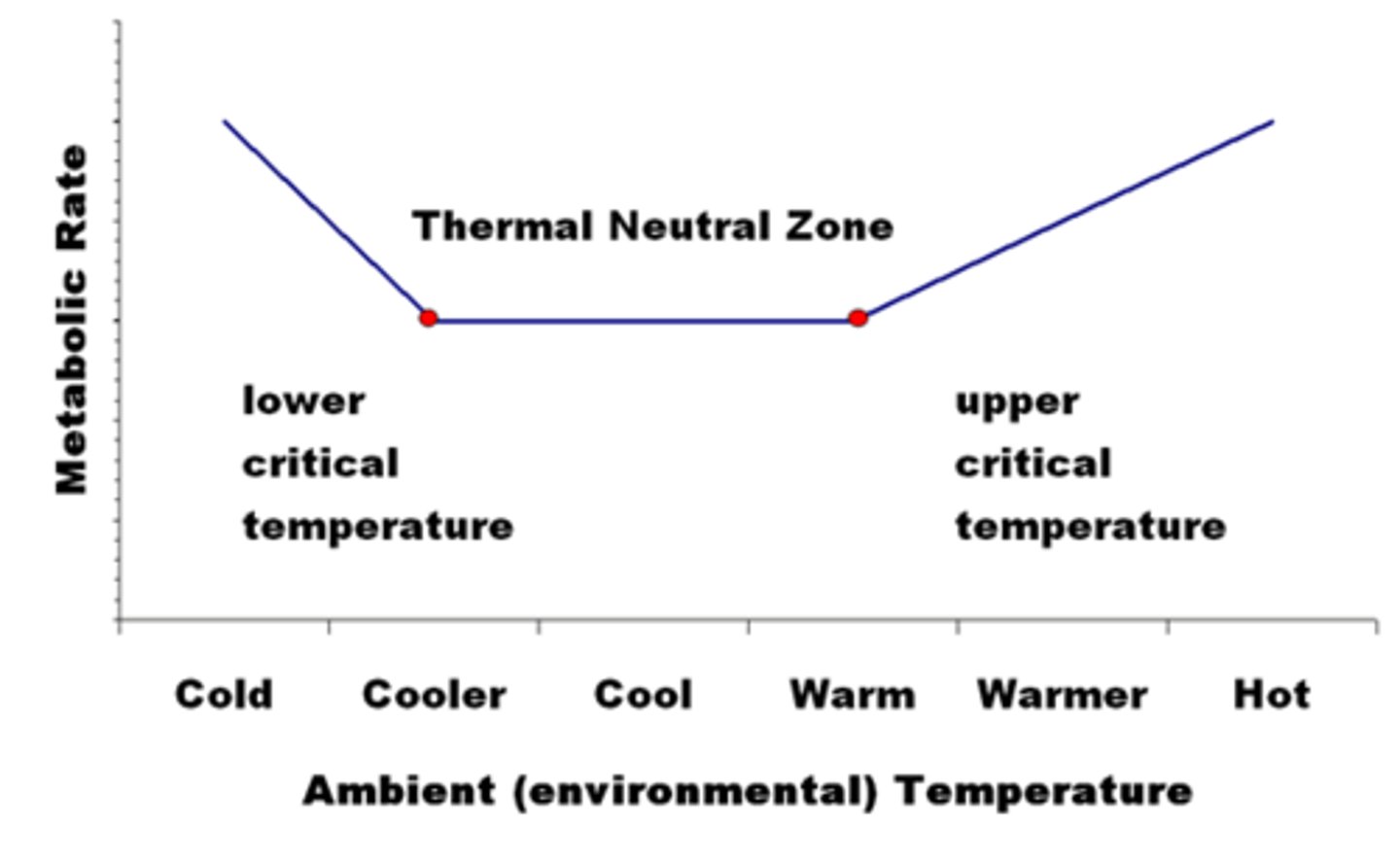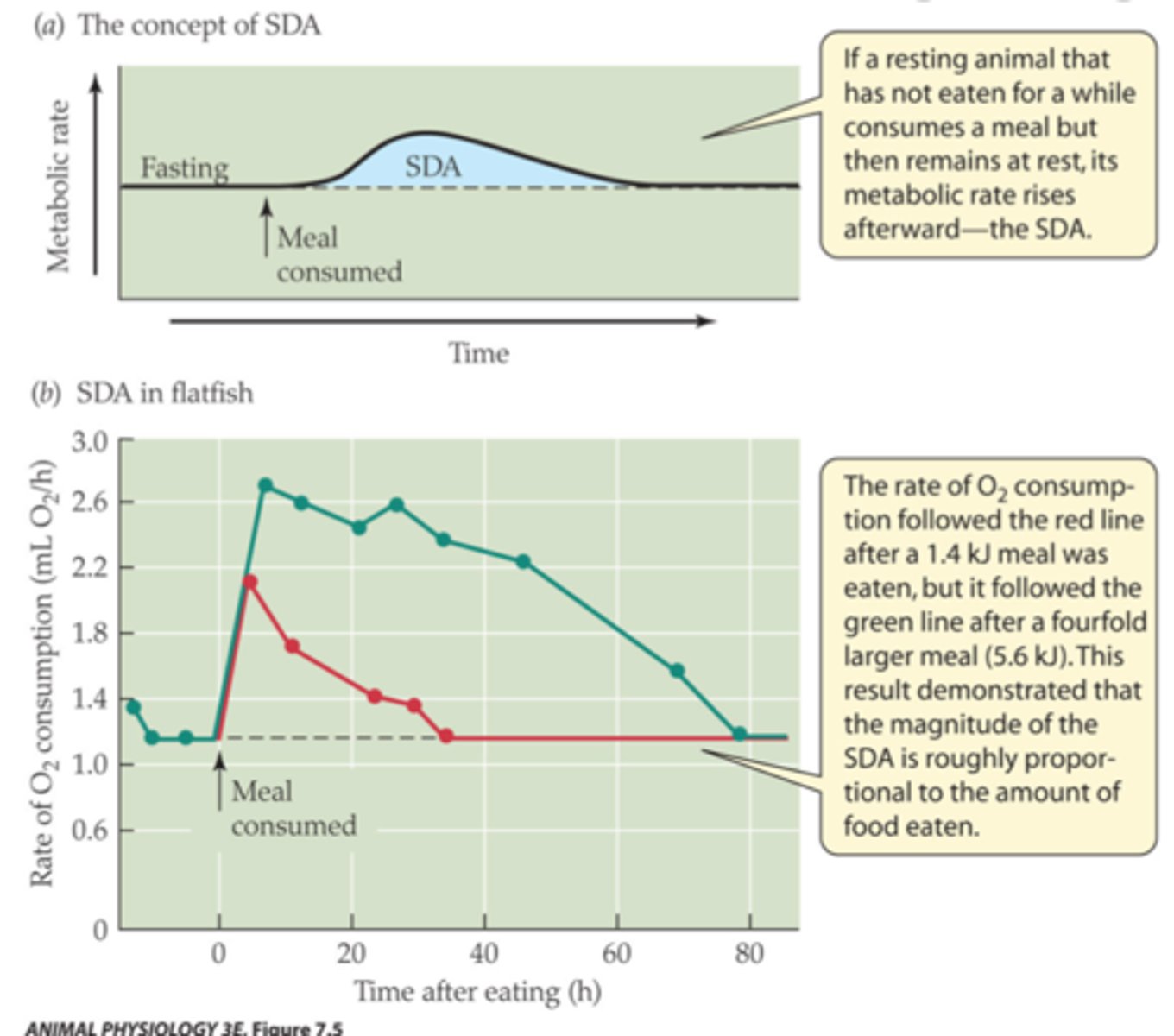(Lecture 12-14) Nutrition, Energy Metabolism and Metabolic Rate
1/47
There's no tags or description
Looks like no tags are added yet.
Name | Mastery | Learn | Test | Matching | Spaced |
|---|
No study sessions yet.
48 Terms
Kinetic vs. Potential energy
- kinetic: energy of movement
- potential: trapped energy
4 different categories of energy
- are they potential, kinetic, or both?
1. Heat:
- radiant (P&K): transmitted from one object to another
- thermal (K): movement of molecules (=molecular kinetic energy)
2. Mechanical (P&K): movement of objects
3. Electrical (P&K): movement of charged particles down a charge gradient
4. Chemical (P): energy stored within chemical bonds
Are the 4 different categories of energy interconvertible?
Yes
types of chemical bonds
& importance for storing energy
1. covalent bond: sharing of electrons. store A LOT of energy
2. non-covalent bonds: moelcules organized into 3d structures. stores LESS energy
How can a weak non-covalent bond like Van der Waals be used to help Gecko stick to the wall?
- many rows of stickly leaves on gecko feet that has lots of hairs.
- the hairs use Van der Waals to attach to surfaces
(T/F) Chemical energy is totipotent.
- explain why or why not
True. Because it can be used for all forms of physiological work.
- mechanical energy can pump blood but can't make protein :(
- electrical energy can set ions in motion, but cant make protein :(
- heat can't do any physiological work :((
What are the 2 main forms of energy storage?
- reducing energy
- high energy bonds - energy can be stored in this bonds, and released when bonds are broken
Which molecule is the most common "high energy" molecule
ATP.
(T/F) In most animals and plants, energy is not stored as ATP
True. It is mostly stored as chemical potential energy.
for example: lipid, carbohydrate, proteins, amino acids
how do we make ATP from the food that we eat?
Food --> acetyl-CoA --> Krebs Cycle --> reducing equivalent (NADH & FADH2) --> ETC --> H+ gradient --> ATP
what are reducing equivalents
when are they formed
- chemical species which transfer the equivalent of one electron in redox reactions.
- formed during the Kreb's cycle to store energy in their hydrogen bonds
how are reducing equivalents important for forming ATP
energy stored in their hydrogen bonds
- brings H+ into the intermembrane space and builds up a chemicalelectrical gradient.
- gradient drives ATP production
3 major functions of energy in animals
1. biosynthesis - synthesis of body constituents from food. accumulation of chemical energy with growth.
2. maintenance: maintaining integrity of the body (e.g. circulation, respiration...)
3. Generation of external work: ATP to generate or drive muscle. application of mechanical force to objects outside of the body
(T/F) The chemical energy accumulated with growth can be converted to ATP
True
(T/F) We keep all the biosynthetic products we make
False. Some are lost (e.g. skin, gamete)
List the 4 sources of ATP
1. Free ATP
2. Phosphagen
3. Anaerobic glycolysis
4. oxidative metabolism
Free ATP
- how the stores are produced
- how quickly the ATP is available to use
- how long the stores lasts
- already in the body
- available instantly
- gone fast - only a few seconds
Phosphagen
- how the stores are produced
- how quickly the ATP is available to use
- how long the stores lasts
- are they effective for ATP production?
- taking the phosphate group from creatine phosphate onto ATP.
- very fast production. fast enzymatic replenishment
- short duration
- ADP + CP --> creatine + ATP (in muscle)
ATP + creatine --> CP + ADP (in mitochondria)
Anaerobic Glycolysis
- how the stores are produced
- how quickly the ATP is available to use
- how long the stores lasts
- are they effective for ATP production?
- glycogen supply in muscle
- fast production
- moderate duration
- energy inefficient (only 2 mol of ATP per mol of glucose)
Oxidative Metabolism
- how the stores are produced
- how quickly the ATP is available to use
- how long the stores lasts
- are they effective for ATP production?
- oxidative phsphorylation
- slow production
- long duration
- quite effective: 34 ATP molecules (+2 from glycolysis)
Explain "Transformation of high-grade energy is inefficient"
glucose -> ATP = ~70% (rest lost as heat)
ATP -> muscular motion = ~25-30% of energy from ATP (loss example: heat during running)
How can we measure the efficiency of energy transformation
output of high grade energy/input of high grade energy
define metabolism
- the set of processes by which cells and organisms acquire, rearrange, and void commodities in ways that sustain life.
- the sum of all chemical reactions in a biologic entity
how does metabolism differ from metabolic rate
metabolic rate refers to the time it takes to convert chemical bond energy to heat & external work.
what can we learn from an animal's metabolic rate?
- how much food an animal needs
- quantitative measure of the total activity of all its physiological mechanisms
- measure how much the animal affects the energy supplies of an ecosystem/agricultural system
what goes into determining metabolic rate of an animal
idk what kind of answer the prof is looking for
- all the factors that affect metabolism? (e.g. body size, diet...)
- how we can measure metabolic rate?
Metabolism scales to the exponent of 0.75, what does this number tell you specifically about how much metabolic rate changes with size (i.e. is it allometric or isometric)?
- allometric: MR doesn't increase in direct proportion to increase in body mass
Endotherm vs. Ectotherm metabolic rates
- why does this difference exists
- what is the mechanism behind this
- endotherm: higher MR. b/c need to maintain body temp via adjustments of metabolic heat production
- ectotherm: lower MR. b/d body temp depends mainly on external sources and behavior
At the same body temperature, similar sized endotherms & ectotherms have ____ (same/different) in oxygen consumption (i.e. metabolism).
differ by at least 4-5 fold
______ (High/Low) demand for food (energy) in endotherms
High
What is the physiological mechanism behind higher MR in endotherms?
(4 mechanisms)
1. increased SA/V ratio in lungs, complex heart (more O2 delivery)
2. organs have higher metabolic activity
3. mitochondrial membrane is 4-5x larger in SA (so ATP production in ETC is more efficient)
4. increased enzyme activity (higher Vmax of enzymes)
How can you measure metabolic rate both directly and indirectly?
- direct: heat production
- indirect: O2 consumed, CO2 produced
what is the definition of 1 calorie
heat required to raise 1g of water by 1 degree celsius
Components that make up energy demand of an animal (5 parts)
- storage
- reproduction/development
- growth
- activity
- maintenance
what is maximum metabolic rate (MMR)
energy required to meet all 5 energy demands of an animal
what is basal/standard/resting metabolic rate (SMR)
the energy required for maintenance
what is aerobic scope? how do we calculate it
- energy needed to do everything to survive when stressed to max level
- MMR-SMR = aerobic scope
What are the factors that affect metabolic rate?
- environmental conditions (e.g. temp)
- activity
- digestion
- starvation
- reproductive state
- time of day
- gender
- body size
How does ambient temp affect metabolic rate
- temp too low: increased MR to maintain body temp
- at thermal neutral zone: don't need to change MR
- temp too high: increased MR to dump heat and cool down
Draw & Explain the Thermal Neutral Zone in relation to ambient temperature & metabolic rate in endotherms

how does feeding/digesting affect metabolic rate
- MR increased to breakdown the food for nutrient & energy
= Specific dynamic action - heat increment of feeding

What is specific dynamic action
refers to the increase in metabolic rate and heat production due to the digestive process (e.g. snake after eating a meal heats up)
effect of meal size on metabolic rate
- and why does starvation lead to a decrease in MR
- large meal: SDA increased in greater magnitude, and last longer.
- starvation: less energy coming in, so we need to process our storage at a slower rate to sustain for a longer time.
why do small animals have a higher mass specific metabolic rate than larger animals
SA:V is larger in small animals
- V produce heat, SA release the heat
- so need to increase MR to offset how much heat we're losing
what does mass-specific MR mean?
the heat produced by a gram of tissue of a particular animal
(basically dividing the MR by the weight)
the effect of body size on weekly food requirements
higher for smaller animals compared to a bigger animal
why can't we have endothermic animals smaller than a hummingbird or a shrew?
b/c they are already working as hard as they possible can as ectotherms that are so small
which of the following has lowest whole animal metabolic rate
- dog
- elephant
- mouse
- rabbit
- mouse. (think about body size & amount of heat produced graph)
(NOT elephant, it would be lowest if its mass specific MR tho)